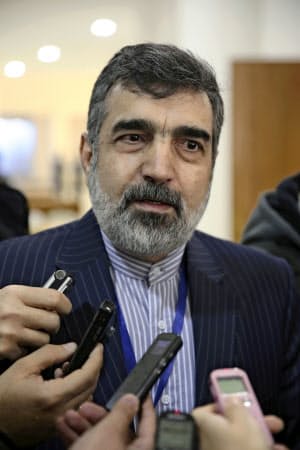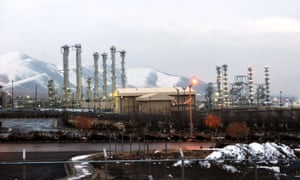【AFP=時事】国際原子力機関(IAEA)は5月31日、イランが2015年に主要6か国と結んだ核合意を引き続き順守しているとする報告書を発表した。核燃料の貯蔵量は増加しているものの、合意の制限内という。
2015年に締結された、正式名称「包括的共同行動計画(JCPOA)」というこの核合意について、イランは先月、一部履行停止すると表明していた。しかし、濃縮ウランと重水の貯蔵量は、核合意で定められた上限を下回っているという。
イランの重水貯蔵量は、5月26日時点で125.2トン。今年2月比で0.4%増えたが、核合意の上限である130トンを超えていない。
濃縮ウランの貯蔵量は、5月20日時点で174.1キロ。今年2月の163.8キロから増加したが、こちらも制限内に収まっている。
IAEAは、高性能遠心分離機「IR-6」の最大33基の導入についてイランと「技術面の協議を進めている」としたが、協議の具体的な内容は明らかにしなかった。
【翻訳編集】AFPBB News
イラン、低濃縮ウラン製造能力を4倍に 保有上限守らず
テヘラン=杉崎慎弥
イラン原子力庁は20日、同国にあるウラン濃縮施設の低濃縮ウランの製造能力を4倍に増強すると発表した。イランが8日に核合意の履行を一部停止し、低濃縮ウランの保有上限を順守しないと宣言したことを受けた措置とみられる。7月上旬までに原油取引などで改善が見られなければ、本格的な核開発を再開する姿勢も示しており、核合意当事国の英独仏などに圧力をかける狙いもある。
イランメディアによると、同庁の報道官が20日に「遠心分離機の数を増やすことなく、(同国中部)ナタンズの施設での低濃縮ウランの製造能力を4倍にする」と表明。国際原子力機関(IAEA)に通知したことも明らかにした。
核合意では、イランの低濃縮ウランの保有上限は300キロと定められている。だが、ロハニ大統領は米国が核合意から離脱してから1年が経過した8日、報復措置として、この上限に縛られない意向などを表明した。核合意にとどまる意思を示す一方で、製造能力を増強し、上限を超える準備を始めたことを明確に示したとみられる。
米国が2日にイラン産原油の全面禁輸に踏み切ったことで、イラン経済はますます窮地に追い込まれている。このため、ロハニ師は英独仏などに原油取引の継続などを要求。「60日以内に目的が達せられないなら、さらなる履行停止を進める」と、無制限のウラン濃縮などを開始する可能性をちらつかせ、核合意の当事国を牽制(けんせい)している。だが、欧州企業は第三国の企業も対象となる米制裁を恐れてイランとの取引には消極的で、状況が改善する見通しは立っていない。(
イランウラン増産、10日以内に貯蔵量が合意を超過と警告
- 2019/6/17 19:01
テヘラン=杉崎慎弥)
6月17日つけ
7月7日から濃縮度をあげる20パーセントまで
Iran to break uranium stockpile limit set by nuclear deal in 10 days
Atomic agency says limit will be breached on 27 June and Iran could start enriching up to 20%
Tehran has sped up the countdown to its breach of the nuclear deal with the announcement that it will exceed its uranium stockpile limit in the next 10 days, raising heightened tensions in the region even further.
The country’s atomic agency also said Tehran might also start the process of enriching uranium up to 20%, closer to weapons-grade, from 7 July.
The announcement by Behrouz Kamalvandi, the spokesman for the Iranian Atomic Energy Authority, puts more pressure on Europe to come up with new terms for the 2015 nuclear deal with Iran.
Q&A
What is the Iran nuclear deal?
The initial response from European leaders was negative. The French president, Emmanuel Macron, urged Iran to be patient and responsible and the German foreign minister, Heiko Maas, said: “We will certainly not accept a unilateral reduction of obligations.”
The US was more forthright. A National Security Council spokesman accused Iran of nuclear blackmail.
The EU agreed an unpublished timetable of its own with Tehran last week to help ease trade between Iran and European nations, but it is not clear whether the measures will come quickly enough or be sufficient to persuade Iran to rethink its strategy of chipping away at the nuclear deal.
Iran says it is acting after Donald Trump pulled the US out of the deal unilaterally a year ago. The EU has since proved itself incapable of protecting its private-sector firms from the threat of US secondary sanctions if they try to trade with Iran. US sanctions have brought down Iran oil exports to 400,000 barrels a day, well below the levels needed to fund government spending.
Washington and the UK have blamed attacks on oil tankers in the Gulf of Oman last week on Iran. Tehran has denied any involvement and described them as a false flag operation. The EU has yet to apportion blame.
Iran’s army chief, Maj Gen Mohammad Hossein Baqeri, said on Monday that if Iran ever decided to block the export of oil from the Gulf, it would do so openly, without resorting to deception or covert operations, unlike the “terrorist and deceptive” US.
Under the terms of the nuclear agreement, Iran can keep a stockpile of no more than 300kg (660lbs) of low-enriched uranium. In a briefing on Monday, Kamalvandi said that given Iran’s recent decision to quadruple its production of low-enriched uranium, it would pass the limit on 27 June.
Timeline
Recent tensions in the Gulf
The UN’s nuclear watchdog, the International Atomic Energy Agency, said last month that Iran’s stockpile of enriched uranium was 174.1kg in late May.
Iran said the breach was likely partly because the US had placed sanctions on Iranian exports of uranium.
Iran also announced water supplies at the Arak water reactor would exceed a 130-tonne limit within the next two and a half months if the country did not find a client to buy heavy water byproducts.
Kamalvandi said Iran needed 5% enrichment for its nuclear power plant in the southern Iranian port of Bushehr and 20% enrichment for a Tehran research reactor. His formulation did not amount to a firm commitment to reach 20% levels.
The nuclear deal had limited Iran to enriching uranium only to 3.67%, which is enough for power plants and peaceful purposes.
Tehran first set the 7 July deadline, after which it might boost enrichment, six weeks ago. Kamalvandi reiterated that stance, saying Tehran would increase uranium enrichment levels “based on the country’s needs”.
Enriching a supply of uranium means boosting its concentration of the isotope U-235, which can power a nuclear reaction. It also involves stripping away atoms of another isotope, U-238.
When uranium is mined it typically has about 140 atoms of U-238 for every atom of U-235. Refining it to a purity of 3.67% means using centrifuges to remove 114 unwanted atoms of U-238 for every atom of U-235.
Boosting its purity to 20% means removing 22 more unwanted atoms of U-238 per atom of U-235, while going from there to weapons-grade material means removing just four more per atom of U-235. Ninety percent is considered weapons-grade.
In an attempt to dramatise Iran’s decision, Kamalvandi spoke to Iranian journalists in a news conference at the country’s Arak heavy water nuclear reactor. Such reactors produce plutonium that can be used in nuclear weapons. Under the nuclear deal, Iran had reconfigured the facility to address western concerns on that issue.
Kamalvandi said the country could rebuild the facility with Chinese help to make it produce plutonium. He also said Iran would continue to allow the UN to inspect its nuclear facilities.
 イランのロハニ大統領=ロイター
イランのロハニ大統領=ロイター
